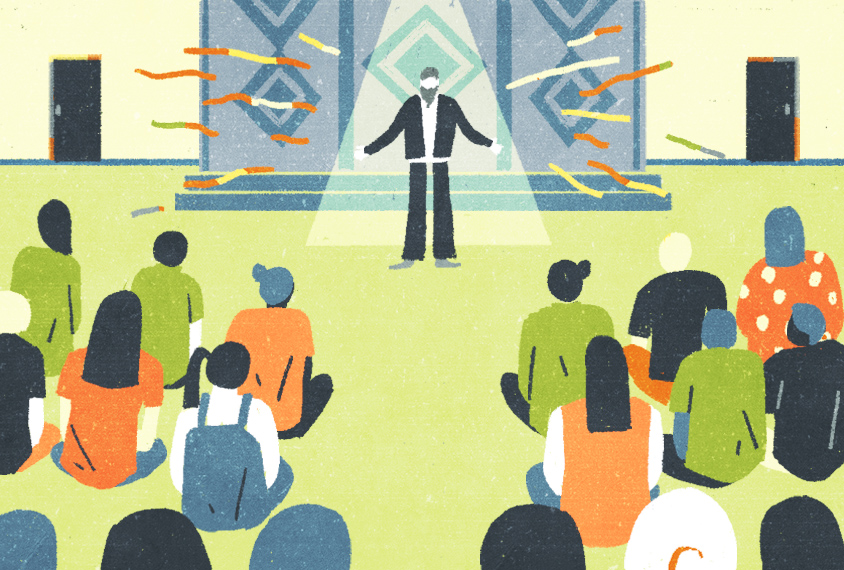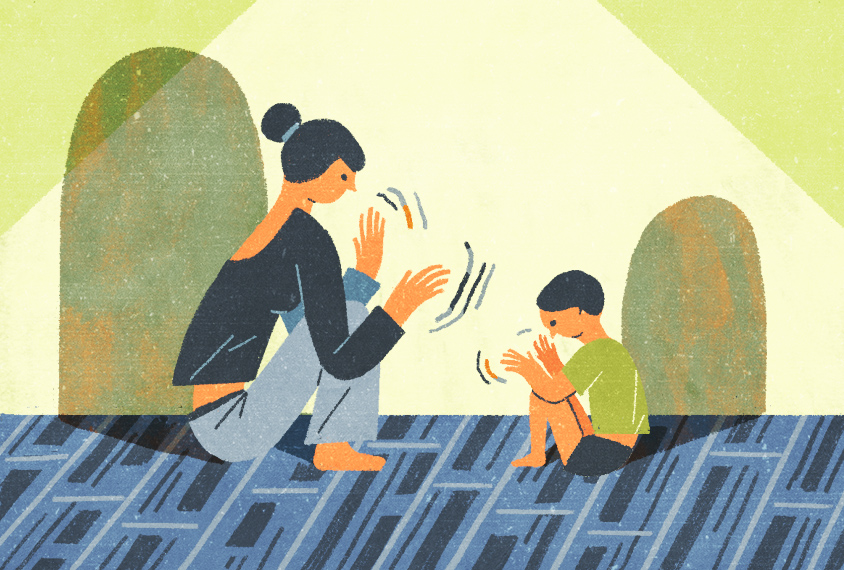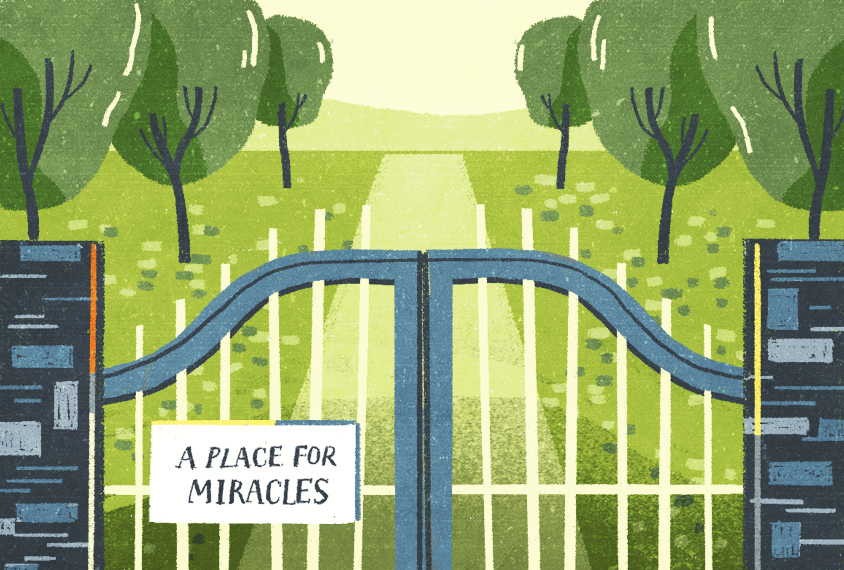
A ‘cure’ for autism at any cost
Scores of parents abandon mainstream autism treatments to pursue Son-Rise, an intense, expensive — and unproven — behavioral therapy.
F
rom the moment her 18-month-old son Sam was diagnosed with autism, Elizabeth B., or Liz, found it difficult to accept. When Sam failed to make much progress in an early-intervention program and, later, at a special-needs preschool in Manhattan, Liz consulted with his speech therapist. The therapist suggested Liz look into the ‘Son-Rise Program,’ taught at the Option Institute’s Autism Treatment Center of America in western Massachusetts. (Liz asked that we not mention her last name, out of concern for her and her son’s privacy.)The name rang a bell with Liz. She had a vague recollection of seeing a 1979 made-for-TV movie called “Son-Rise: A Miracle of Love.” In the movie, a New York advertising executive named Barry Neil Kaufman and his wife ‘cure’ their son’s autism at home, spending more than eight hours a day immersed in his world and copying his behaviors.
The therapy seemed worth a shot. So in August 2005, Liz and her husband paid $1,623 in fees, left Sam, then almost 4, with a family friend, and drove to the institute’s 100-acre campus for a five-day Son-Rise ‘startup’ class. The angular brown buildings scattered in the woods give the institute the look of a New Age monastery. Adding to the monastic vibe, participants are advised to leave their valuables at home because the dormitory doors lock only from the inside.
Liz hadn’t anticipated how deeply the experience would affect her. Having a child with autism can feel isolating, and because Sam didn’t participate in school activities or have friends, she had few friends herself. But on the first day of the Son-Rise Program, as she took a seat on the floor of the lecture hall with about 100 other parents, she immediately felt at ease. “You have a powerful sense that you are with cousins,” she says.
On Tuesday evening, Barry Neil Kaufman, known as “Bears,” made his rounds in the dining hall, clad in his usual getup: a blazer and a black turtleneck. Liz found his message of love and acceptance intoxicating and, for the first time since Sam’s diagnosis, felt she had a way to help her son. When Kaufman spoke of children with autism as having limitless potential, his words resonated strongly with Liz.

Over the next four years, she spent nearly $50,000 on Option Institute programs, both for Sam, her husband and herself, and to train as a mentor for other parents. Although that amount may seem extreme, she is hardly alone: More than 30,000 families from more than 120 countries have participated in the Son-Rise Program over the past three decades, according to the institute. Some families pay full price to attend multiple courses, others receive scholarships from the institute, and a few even resort to crowdfunding. “Your generosity would allow our beloved son to experience the best treatment available,” reads one plea to raise $25,000 on the GoFundMe website.
The prices at the institute are especially steep given that states such as California and New York pay for a wide range of evidence-based interventions. Son-Rise startup classes are advertised as $2,200 per parent; an ‘intensive’ course, attended by parents and children, can run to $18,000. “Should you be selling your house to pay for this extraordinarily expensive program?” asks Catherine Lord, founding director of the Center for Autism and the Developing Brain at New York-Presbyterian Hospital in New York. “That’s where we are getting worried.”
Investing in Son-Rise, experts say, is a little like buying a lottery ticket. “I’m not aware of any rigorous scientific evidence that supports it,” says Fred Volkmar, head of the Autism Program at Yale University. There are no independent clinical trials or scientific studies of Son-Rise to back the institute’s claims that the program “helps parents cure their children in some cases” and “achieve significant improvement in almost all cases.”
At the same time, autism researchers express frustration that the Kaufmans discourage parents from combining Son-Rise with proven behavioral therapies and direct them instead toward alternative treatments, such as horse therapy and homeopathy. Some former employees Spectrum interviewed describe the institute as rule-bound, lacking in transparency and focused on fundraising. The Kaufmans, they say, control nearly every detail of the program and demand unstinting loyalty from staff and commitment from families.
Bryn Hogan, executive director of the institute’s Autism Treatment Center of America and the Kaufmans’ daughter, says that the center welcomes more research on its programs and that the criticism it’s received is unfair or inaccurate. “People tend to be suspicious of things they don’t fully understand,” she says.
Love conquers all:
W
hen the Son-Rise Program launched, it was, in some ways, considered revolutionary. In the 1970s, scientists understood little about the biological basis of autism, and the options to help children with the condition were few and far between. “We didn’t know anything about what to do with them,” says Bryna Siegel, a developmental psychologist and founder of the Autism Center of Northern California, a nonprofit organization that provides diagnosis, treatment planning and support.In his now-discredited 1967 book, “The Empty Fortress,” psychoanalyst Bruno Bettelheim blamed cold, unresponsive “refrigerator mothers” for autism and recommended institutionalizing their children. At the same time, psychologist Ole Ivar Løvaas had started to advocate the use of rewards and punishments to help children on the spectrum communicate more and harm themselves less. His approach, which now falls under the umbrella of applied behavioral analysis (ABA), is the most widely used therapy for autism, but it is not without controversy. Some adults on the spectrum who have experienced ABA decry the idea of forcing children with autism to conform to neurotypical standards of behavior.
Son-Rise, by contrast, is intended to tap into the well of unconditional love that parents feel for their child. Although the Option Institute declined to make Kaufman available for interviews, he responded by email to questions regarding this article. He also described the method and its origins in detail in his 1976 memoir and in subsequent publications and videos. With dark, expressive eyebrows and a snow-white beard, Kaufman looks less like a young James Farentino, who plays him in the movie, and more like an aging folk singer.
The Son-Rise story, as Kaufman relays it, begins with his third child, Raun. As an infant, Raun had a severe ear infection that nearly killed him, and he subsequently retreated inside himself. By the time he was about a year old, the curly-haired boy spent hours each day rocking back and forth or spinning plates on their edges. When he was 18 months old, doctors diagnosed him with autism and an intelligence quotient (IQ) under 30. In the Son-Rise movie, which is based on Kaufman’s memoir, one physician tells Kaufman and his wife she can do nothing for Raun until the boy is 3 years old and, even then, it will make little difference. “Wait a minute, wait a minute, Dr. Field. Are you saying autism is not curable … it’s not treatable?” Kaufman asks.
“I’m saying that we can’t offer him much hope,” the physician replies.
Kaufman refused to accept her statement. He was an adherent of the ‘Option Method,’ a self-help movement built on the idea that people can change their feelings by changing their beliefs. “It was not merely a philosophy,” Kaufman later wrote in his memoir, “but a vision that would become the basis for our way of life and a foundation from which we would try to help Raun.”
Raun’s parents chose to see him much as they saw his neurotypical sisters — a child who could choose his own fate. Each morning, his mother, Samahria, shut herself and her son in the downstairs bathroom — a ‘playroom’ where they would be free from distractions. Instead of trying to quell his repetitive ‘stimming’ behaviors, as an ABA therapist might do, she joined him. And after five months, Kaufman says in his memoir, Raun was speaking more, eating by himself and playing with family members. The parents continued to work with their son for three more years — at which point he bore “absolutely no traces of his original condition.”
When Raun was 10, the family bought 86 acres of land in Massachusetts for $400,000 and founded the nonprofit Option Institute to share their methods with other parents and would-be practitioners. Today, the Autism Treatment Center of America’s website describes Raun, its global director of education, as having a “near-genius” IQ. “I’ve lived the life I was never supposed to live,” the 43-year-old Brown University graduate wrote in his 2014 book.
The institute often features Raun in its advertising and plays up the contrasts between Son-Rise and ABA, criticizing the more widely accepted approach for having lax training standards for facilitators and creating “robotic” children. In 2010, for instance, Raun produced a series of videos that were a play on the “Get a Mac” ad campaign from the early 2000s. In his version, a slouching nerd in a tie represents ABA, whereas Raun, sporting a hip goatee and a black leather jacket, embodies Son-Rise. “Would you rather your child be able to perform 25 scripted behaviors or would you rather he be able to relate to people?” he asks.
Optimal outcomes:
H
ogan says that her adopted daughter, Jade, now 22, has also “recovered” from autism thanks to Son-Rise. (Jade was never diagnosed outside the institute.) For decades, recovery stories like this confounded researchers, who characterized autism as a lifelong condition. When they came across a child who seemed to lose his diagnosis, they often assumed he had initially been misdiagnosed. In her 1996 book, Siegel has expressed skepticism about Raun’s autism diagnosis alongside her doubts about the program.Since that time, however, opinions about the permanence of an autism diagnosis have started to shift. A 2008 review of autism outcomes reported that between 3 and 25 percent of individuals with autism may eventually outgrow that label. Rather than calling these children ‘cured,’ researchers prefer to say the children have achieved an ‘optimal outcome.’ Some of these children become virtually indistinguishable from their neurotypical peers, says Deborah Fein, professor of psychology at the University of Connecticut, who has led much of the research. Magnetic resonance imaging (MRI) scans, however, reveal that the children recruit different brain areas during certain language comprehension tasks than typical children do. The finding suggests that instead of recovering, these children find ways to compensate for their neurological differences.

The big question for both parents and doctors is whether behavioral therapy can increase the odds of achieving an optimal outcome. One 2014 study compared the histories of 34 children and adolescents at the mild end of the spectrum with 25 individuals who had achieved ‘optimal outcome.’ It found that the latter were more likely to have had a diagnosis by the age of 4 and, consequently, ended up receiving more attention from therapists, notably ABA practitioners. “The window is most open the younger they are,” Fein says. Other studies suggest that the type of intervention is less important than the families’ participation.
Despite her own doubts about Son-Rise, Siegel has seen at least one child who participated in the Son-Rise program lose his autism diagnosis — a diagnosis she made herself. In November 1996, Lisa Kay brought her nearly 3-year-old son, Michael, for an evaluation at the University of California, San Francisco, where Siegel served as director of the autism program. Michael was spending up to an hour every day rocking back and forth to MTV videos, making the sound “ee-ee.” Siegel concluded that Michael met “seven or eight diagnostic criteria for autism,” according to her records. (Although these checklists have since changed, at the time, a diagnosis called for six.)
Kay followed Siegel’s recommendation that Michael begin speech therapy, but rather than enroll him in the behavioral therapy Siegel suggested, she started him on a Son-Rise program. Still, when Siegel reexamined him two years later as part of a study following young children with autism, he no longer met the autism criteria, although he had some lingering speech difficulties. After Michael graduated from high school, the Option Institute posted a video of him on YouTube with the title “Michael Fully Recovers From Autism with The Son-Rise Program.” (The video had more than 79,000 views as of September). “I wouldn’t deny that Son-Rise was an active ingredient,” Siegel says, “But I think it was unlikely that it was the only active ingredient.”
Michael, now in his 20s, is tall and sturdily built and has an unguarded, earnest manner. After he graduated from college, he interviewed for a job with the Option Institute but says he wasn’t “animated” enough — something he says the institute’s staff prize in the employees they train to work with children. Even so, Son-Rise is still a big part of his identity. When he isn’t at work as an insurance broker, he volunteers to help a local family the institute put him in touch with. Because the program recommends at least 20 and ideally more than 40 hours of treatment a week, families often recruit a half-dozen or more ‘play’ volunteers, from high school students to adults like Michael who are interested in autism.
One morning in March, I joined Michael as he drove out to meet the family in Pleasanton, California. On this Sunday, as soon as Michael gets out of his truck, a gangly 13-year-old named Jay runs up and puts his arm around Michael, hustling him upstairs to the family’s playroom. As the Son-Rise program recommends, the room has a one-way mirror on the door, and is empty except for a few cushions for seating, along with props brought in based on the child’s interests. Jay is fascinated by birthdays, for example, and on the walls of his playroom hang sheets of paper listing the birthdays of Jay’s volunteers, friends and family members.
For the next half hour, Jay sings songs from the TV show “The Wiggles” in a raspy, whispering voice. That’s his ‘ism’ — the Son-Rise term for a repetitive behavior. Michael intermittently tries to join in. At one point, Jay touches Michael with his bare feet. “What am I going to do with these feet?” Michael asks. “Want me to tickle these feet?”
“Squeeze my feet,” Jay says.
Jay’s mother, Madhuri Reddy, a former biochemist, says she has no illusions that Son-Rise will cure Jay. But since Jay started the program, she says, he has had fewer “meltdowns.” Michael also seems to have a sober opinion of the possible outcomes. “He might not recover to the same extent I have,” he says. “I think it’s okay to accept that because he’s happy.”
”“I’m not aware of any rigorous scientific evidence that supports it.” Fred Volkmar
No proof:
‘H
appy’ is important, but it’s only through rigorous, long-term studies that researchers can establish which programs are effective and which are fluff. Siegel, Lord and other experts acknowledge that components of the Son-Rise Program — intense parental involvement and an early start — might be beneficial for children with autism. For example, a 2012 clinical trial found that when parents learned to curb their pessimism about children with challenging behaviors, those children were more likely to improve. And one classic 1984 study suggested that children with autism are more likely to interact with an experimenter if she imitates their actions.But after 30 years, there is no independent evidence that the program leads to success stories like Raun’s or Michael’s — or even modest improvements like Jay’s. In fact, at least one study has found that the intensity of the program can sometimes increase family stress levels. That 2003 survey of 87 parents who had pursued Son-Rise concluded that the program “led to more drawbacks than benefits for the families over time.” Part of that may be a matter of expectations. In 2009, the United Kingdom’s Advertising Standards Authority sanctioned the institute for misleading the public after they ran an ad touting Son-Rise as an autism “cure.”
In 2013, psychologist Kat Houghton, a former employee of the Option Institute, published the first attempt to evaluate the Son-Rise Program, studying only 12 children with autism. According to court records, the institute agreed to pay Houghton $16,500 to gather, code and analyze data for the treatment study, but Houghton did not disclose any conflict of interest in the published article. Houghton directed questions about the research funding to psychologist Charlie Lewis at Lancaster University in the U.K., who is a co-author on the study and her Ph.D. advisor. Lewis says he was unaware that Houghton was explicitly paid for that research, but that they had both been “passionately committed to an unbiased study design and a completely independent research process.”
Last year, two researchers, including one of Houghton’s co-authors, tried to gauge the program’s effectiveness from another angle, surveying 49 parents who had attended two five-day Son-Rise courses at the institute. But they based their positive conclusions on the parents’ subjective assessments. Anecdotally, at least, negative reviews of Son-Rise from parents are hard to come by. Spectrum spoke with a number of parents who felt the program had given them powerful tools for connecting with their children, though they disliked the program’s rigidity. Some, like Liz, ended up feeling deeply conflicted.
After Liz’s initial stay at the institute in 2005, she and her husband moved to the lower level of their Manhattan duplex and turned their upstairs bedroom into Sam’s playroom, complete with a padded floor and a video camera. Liz recruited a half-dozen volunteers who joined Sam whenever he stimmed. She says the program was instrumental in getting Sam to begin to speak and to use the toilet on his own. “For me, that’s Son-Rise,” she says.
At other times, though, she questioned whether she was doing the right thing — particularly after she paid $10,000 in 2006 to bring Sam to a weeklong session that the institute’s website claims can lead to more than 90 percent increases in a child’s attention span, eye contact and language use. The program was supposed to be personalized, but she says it felt pre-packaged. In 2009, she enrolled in another expensive month-long course at the institute to become certified as an ‘option process mentor.’ She hoped to work with other families in her community, and soon got referrals from Houghton. At the time, Houghton was also working as a mentor and was running a business that combined Son-Rise with other therapies.
The Kaufmans, however, apparently grew worried that Houghton was poaching their clients and diluting their message. In February 2010, the Option Institute sued Houghton in federal court, alleging trademark infringement, unfair competition and breach of contract. The institute’s staff then started asking mentors to take sides. Raun Kaufman called Liz and told her she could not remain certified or attend future courses unless she cut ties with Houghton, according to an affidavit from Liz filed in that lawsuit. (Bryn Hogan’s affidavit says the institute did not make any such threat.) “In effect, she is stealing from the Option Institute,” Liz remembers him telling her.
According to Liz’s affidavit, she asked if he was giving her an ultimatum; he replied that he was.
“It was like I was being shunned,” Liz says. Although the case between the Kaufmans and Houghton was settled out of court, Liz felt wounded. They had drawn her in with a message of love and acceptance, but it seemed that applied only to a loyal inner circle. “The whole premise that they base their program on wasn’t something they were living up to in their own business practices,” she says.
”“Should you be selling your house to pay for this extraordinarily expensive program?” Catherine Lord
Selling hope:
L
iz’s sudden expulsion from the Son-Rise community jibes with stories that several former employees told Spectrum, casting the Kaufmans as controlling. Allegations that the organization is a cult are hyperbolic, they say, but it is unquestionably quasi-religious: The institute’s articles of incorporation describe it as providing a “path to God,” and staff members sign off on emails to each other with “Love.”Steven Wertz, a seminary graduate who befriended the Kaufmans in the early 1980s and went to work for them soon thereafter, recalls the early days of the institute as inspiring. But after 15 years of working for the institute, his enthusiasm waned. He says Kaufman asked him to ghostwrite a Son-Rise manual. Wertz wanted credit but says Kaufman viewed him as a disciple who had learned everything from him; Wertz refused the offer. “From that moment onward, I was on the way out,” he says. “You don’t, under most circumstances, say ‘no’ to Mr. Kaufman.” (Kaufman refutes this version of events, but did not offer details.) Wertz later became ABA-certified and founded the Growing Minds Autism Programs in Colorado, which trains parents to work with their children.
Andrew Shahan, who worked as a child facilitator at the institute in the late 1990s, says he had a similar experience. He remembers calling one mother, who broke down in tears; she felt she had failed at the program because she couldn’t keep up with the costs. “This felt wrong to me,” Shahan says. When Shahan aired his doubts about how families were being pressured, he says he too was nudged toward the exit. He went on to get a master’s degree in special education at San Francisco State University and is now director of child development at the Center for Social Dynamics in California, a company that provides diagnostic services, ABA-based treatment plans and support services.
Today, the upper ranks of the Option Institute are mostly members of the Kaufman family, who have a home on the campus. In 2015, Bears and Samahria Kaufman received a combined salary of approximately $240,000, along with $260,000 for the lease of the property on which they built the campus. Combined with donations and other unspecified sources of income, the institute’s annual revenues approach $6 million, according to tax documents. The Son-Rise Program brings in more than $2.5 million of that through classes held in the United States, the U.K., Singapore and other countries.
They are impressive earnings for an intervention that, even when it helps, may not lead to sustained improvements. In Sam’s case, for example, his progress tapered off after his initial gains. At almost 16, Sam has just completed 8th grade in a special-needs class, where he was taught ‘life skills,’ such as making coffee with a Keurig machine and selling it to teachers. “Their expectation of his development was so low,” Liz says.

She and her husband recently decided to take Sam out of public school and enroll him in a program for children with brain injuries at the Institutes for the Achievement of Human Potential in Philadelphia. That program, which costs more than $6,000 for two weeklong sessions, involves a number of physical exercises, including “masking,” in which Sam breathes into a plastic bag for up to a minute. The idea is that this dilates his blood vessels, and when the bag is removed, his brain gets a burst of oxygen. “We’re doing this up to 60 times a day,” she says.
When Sam’s pediatrician told Liz that, as with Son-Rise, there is little evidence to back up the oxygen program, Liz brushed off the doctor’s skepticism. “We have nothing to lose,” she says.
Corrections
This article has been modified from the original. Bryna Siegel is a developmental psychologist, not a psychiatrist. Also, Charlie Lewis is Kat Houghton’s former, not current, Ph.D. advisor.
Syndication
This article was republished in Slate.
Recommended reading

PTEN problems underscore autism connection to excess brain fluid

Autism traits, mental health conditions interact in sex-dependent ways in early development

New tool may help untangle downstream effects of autism-linked genes
Explore more from The Transmitter

